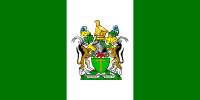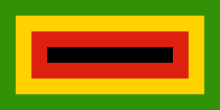Flag of Zimbabwe
 | |
| Use | National flag and ensign |
|---|---|
| Proportion | 1:2 |
| Adopted | 18 April 1980 |
| Design | Seven horizontal stripes of green, gold, red and black with white triangle containing red 5 point star with Zimbabwe Bird |
 | |
| Variant flag of Zimbabwe | |
| Name | Presidential Flag of Zimbabwe |
| Adopted | 1987 |
The national flag of Zimbabwe consists of seven even horizontal stripes of green, gold, red and black with a white triangle containing a red 5 point star with a Zimbabwe Bird. The present design was adopted on 18 April 1980, when Zimbabwe was granted independence by the United Kingdom. The soapstone bird featured on the flag represents a statuette of a bird found at the ruins of Great Zimbabwe. The bird symbolizes the history of Zimbabwe; the red star beneath it symbolizes Marxism, and the revolutionary struggle for freedom and peace. It is similar to the flag of Zimbabwe's ruling party, Zimbabwe African National Union – Patriotic Front.
History
The country now known as Zimbabwe was formally known as Southern Rhodesia from 1895 to 1980—the name Rhodesia was locally used from 1964 to June 1979, and Zimbabwe Rhodesia was thereafter in use until December 1979. Southern Rhodesia achieved responsible government in 1923, and thereby became a self-governing colony of Britain following three decades of rule by the British South Africa Company. It concurrently adopted its first flag: following standard British colonial practice, it was a Blue Ensign, defaced with part of the Southern Rhodesian coat of arms. This basic design remained until 1968; the shade of blue was lightened in 1964. In 1968, three years after the mostly white government unilaterally declared independence from Britain, a completely new national flag was adopted: a green-white-green horizontal triband, charged centrally with the national coat of arms. This was the first national flag to contain the Zimbabwe Bird, which had been present in the coat of arms since 1924.[1]
In 1979, when the country reconstituted itself as Zimbabwe Rhodesia following the Internal Settlement between the government and moderate black nationalists, a new flag was adopted to mark the transition.[2] The flag of Zimbabwe Rhodesia was designed by Flight Lieutenant Cedric Herbert of the Rhodesian Air Force and a member of the Rhodesian Heraldry and Genealogy Society.[3] The design incorporated the pan-African colours of yellow, black, green and red; the black stripe symbolised majority rule in the country and the red stood for the struggle to achieve this. The yellow and green respectively represented the nation's mineral wealth and its agricultural and natural resources. The thin vertical white stripe represented the white minority while the central horizontal white stripe represented peace.[2]
This flag was superseded in December 1979, when Britain took interim control of the country following the Lancaster House Agreement, which ended the Rhodesian Bush War. The British Union Jack was used as the official flag of the country while fresh elections were held in early 1980, and at midnight between 17 and 18 April 1980, the country was granted independence by Britain under the name Zimbabwe. A new flag was concurrently adopted,[4][5][6][7] the draft for which was handed to Minister of Public Works Richard Hove by an unspecified designer. It initially did not have the Zimbabwe Bird included in it; Cedric Herbert added it in later on. The final draft (the flag as it is now) went through the approval of the then-Prime Minister-elect Robert Mugabe.[3] The adoption of the new flag coincided with the swearing-in of Canaan Banana as the country's new president.[5] The Zimbabwe Bird, used on every flag since 1968, is based on a bird statue discovered from the ancient ruined city of Great Zimbabwe in the country's south-east.[8]
Gallery of past flags
-

Flag of Southern Rhodesia 1923–1964
-
.svg.png)
Flag of Rhodesia 1964–1968
-

Flag of Rhodesia 1968–1979
-

Flag of Zimbabwe Rhodesia 1979
Display and use
Flag etiquette
There are certain guidelines for the use, display and disposal of the national flag of Zimbabwe. The flag should never be allowed to come into contact with the ground. Should the flag reach a stage where it is no longer deemed worthy of the public eye, such as when it is torn and tattered, it should be "destroyed in a dignified way" with "all due care and respect". After which, the disposed flag should have a new one in its place.[9] According to Patrick Chinamasa, Zimbabwean Minister of Justice and Legal Affairs, any company in Zimbabwe can manufacture the national flag, so long as it does not "imprint on it anything that should not be on the national flag", and the flag can be displayed anywhere deemed fit by the people.[10]
Display on uniforms
Some police officers in Zimbabwe have the national flag displayed on their uniforms' sleeve tops.[11]
Design
Colours and symbolism

The national flag of Zimbabwe is made up of five different colours: Green, yellow, red, black and white.[12] Officially, the colours of the flag of Zimbabwe carry political, regional, and cultural meanings. Green represents the agriculture and rural areas of Zimbabwe. Yellow stands for the wealth of minerals in the country,[6] predominantly gold. The red symbolises the blood shed during the first and second Chimurenga (wars) in the "struggle for independence". The black indicates the heritage, ethnicity and community of the native Africans of Zimbabwe.[6][13]
The white triangle is a symbol for peace.[6] The golden bird,[14] known as the "Great Zimbabwe Bird" is the national symbol of Zimbabwe.[6] A representation of most likely the bateleur eagle or the African fish eagle,[15][16] it "exemplifies the strong bond that ancestral humans had with animals, nature and spirit guides" and it is treated with a high level of importance and respect.[17] The red star represents the nation's hopes and aspirations for the future.[6]
Specifications
The Great Zimbabwe Bird should be forty units both high and low.[3] The red star is not regular.[3] The black bar is three units wide.[3] The white triangle is isosceles, with a base and height of some 84 units.[3]
Similarities

The colors used on the flag of Zimbabwe are closely shared with that of the Zimbabwe African National Union – Patriotic Front's.[18] This is viewed as a sign of humble submission and respect towards the party.[19]
In popular culture
On 7 August 1980, Samora Machel once made a prominent speech involving the national flag of Zimbabwe, in which he said while holding the flag, "This flag covers everyone. There are no blacks in Zimbabwe, there are no whites, there are no mulattos and Indians, today there are just Zimbabweans."[20]
In Harare, Zimbabwe, every other car has one to many miniature national flags plastered onto it. Sales of the national flag are sky-high in the country and this helps to curb inflation rates.[10] According to Petina Gappah of The Guardian, the flag is a "reminder that the nation was born of pain".[21]
It is a breach of Zimbabwean law to sell products bearing the colours of the national flag of the country.[22]
See also
References
- ↑ Smith, Whitney, ed. (1976). The Flag Bulletin. Volumes 15–17. Winchester, Massachusetts: Flag Research Center. p. 46.
- ↑ 2.0 2.1 Berry, Bruce. "Zimbabwe: Zimbabwe Rhodesia (1979)". Crw Flags. Retrieved 5 June 2013.
- ↑ 3.0 3.1 3.2 3.3 3.4 3.5 "Designer of the Flag". Crw Flags. Retrieved 5 June 2013.
- ↑ Kalath, Anjali. Flag Book. Popular Prakashan. pp. 23–. ISBN 9788179915127.
- ↑ 5.0 5.1 Lan, David (1985). Guns and Rain: Guerrillas and Spirit Mediums in Zimbabwe (4 ed.). University of California Press. pp. 217–. ISBN 9780520055896.
- ↑ 6.0 6.1 6.2 6.3 6.4 6.5 Di Piazza, Francesca (2005). Zimbabwe In Pictures. Twenty-First Century Books. pp. 69–. ISBN 9780822523994.
- ↑ Horne, Gerald (2001). From the Barrel of a Gun: The United States and the War Against Zimbabwe, 1965–1980. UNC Press Books. pp. 3–. ISBN 9780807849033.
- ↑ Great Zimbabwe (11th–15th century) | Thematic Essay | Timeline of Art History | The Metropolitan Museum of Art
- ↑ Alchin, Linda. "Zimbabwe Flag". Vexillology Matters. Retrieved 5 June 2013.
- ↑ 10.0 10.1 "Flood of flags sweeps Harare". The Zimbabewan. 23 February 2011.
- ↑ Wiles, Richard F. (2005). Foredoomed is My Forest: The Diary of a Zimbabwe Farmer. Trafford Publishing. pp. 257–. ISBN 9781412055840.
- ↑ Lawson, Jennifer Elizabeth (2005). Hands-on Social Studies : Grade 2 (2 ed.). Portage and Main Press. pp. 188–. ISBN 9781553790563.
- ↑ "Zimbabwe". CIA World Factbook. Retrieved 5 June 2013.
- ↑ "National Flag". Government of Zimbabwe. Retrieved 5 June 2013.
- ↑ Thomas N. Huffman (1985). "The Soapstone Birds from Great Zimbabwe". African Arts 18 (3): 68–73, 99–100. JSTOR 3336358.
- ↑ Paul Sinclair (2001). "Review: The Soapstone Birds of Great Zimbabwe Symbols of a Nation by Edward Matenga". The South African Archaeological Bulletin 56 (173/174): 105–106. JSTOR 3889033.
- ↑ Redfern, Gayle (2010). Ancient Wisdoms. AuthorHouse. pp. 201–. ISBN 9781452016634.
- ↑ Philip, George (2002). Encyclopedic World Atlas (6 ed.). Oxford University Press. pp. 241–. ISBN 9780195219203.
- ↑ Cerulo, Karen A. (1995). Identity Designs: The Sights and Sounds of a Nation. Rutgers University Press. pp. 105–. ISBN 9780813522111.
- ↑ Fauvet, Paul (2003). Carlos Cardoso: Telling the Truth in Mozambique. Juta and Company. pp. 73–. ISBN 9781919930312.
- ↑ Gappah, Petina (14 April 2010). "Mugabe inflames the Afro-pessimists, but Zimbabwe's story is much deeper". The Guardian.
- ↑ Worsam, Mike (2002). Effective Management for Marketing: 2002 - 2003 ; [2002 Advanced Certifivate Syballus]. pp. 79–. ISBN 9780750657068.
External links
| Wikimedia Commons has media related to Flags of Zimbabwe. |
| ||||||||||||||
| ||||||||||